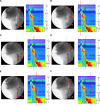Videofluoroscopic and manometric evaluation of pharyngeal and upper esophageal sphincter function during swallowing
- PMID: 24847841
- PMCID: PMC4102160
- DOI: 10.5056/jnm14021
Videofluoroscopic and manometric evaluation of pharyngeal and upper esophageal sphincter function during swallowing
Abstract
Background/aims: The purpose of this study was to determine important manometric metrics for the analysis of pharyngeal and upper esophageal sphincter (UES) function and to investigate the effect of viscosity and other confounding factors on manometric results.
Methods: Manometric studies were performed on 26 asymptomatic volunteers (12 men and 14 women; age, 19-81 years). The manometric protocol included 5 water swallows (5 mL), 5 barium swallows (5 mL) and 5 yogurt swallows (5 mL). Evaluation of high-resolution manometry parameters including basal pressure of the UES, mesopharyngeal contractile integral (mesopharyngeal CI, mmHg · cm · sec), CI of the hypopharynx and UES (hypopharyngeal CI), relaxation interval of UES, median intrabolus pressure and nadir pressure at UES was performed using MATLAB.
Results: Mesopharyngeal CIs for barium and yogurt swallows were significantly lower than those for water swallows (both P < 0.05). Hypopharyngeal CIs for water swallows were significantly lower than those for barium swallows (P = 0.004), and median bolus pressure at UES for barium swallows was significantly higher than that for water and yogurt swallows (both P < 0.05). Furthermore, hypopharyngeal CI and median intrabolus pressure at UES were significantly related to age for 3 swallows (all P < 0.01 and P < 0.05, respectively). A significant negative correlation was also noted between nadir pressure at UES and age for water and yogurt swallows (all P < 0.05).
Conclusions: Manometric measurement of the pharynx and UES varies with respect to viscosity. Moreover, age could be a confounding variable in the interpretation of pharyngeal manometry.
Keywords: Manometry, Deglutition, Esophageal sphincter, upper, Fluoroscopy, Pharynx.
Figures







Similar articles
-
Upper esophageal sphincter function during deglutition.Gastroenterology. 1988 Jul;95(1):52-62. doi: 10.1016/0016-5085(88)90290-9. Gastroenterology. 1988. PMID: 3371625
-
Effect of bolus volume on pharyngeal swallowing assessed by high-resolution manometry.Physiol Behav. 2014 Apr 10;128:46-51. doi: 10.1016/j.physbeh.2014.01.030. Epub 2014 Feb 8. Physiol Behav. 2014. PMID: 24518872
-
Effects of age, gender, bolus condition, viscosity, and volume on pharyngeal and upper esophageal sphincter pressure and temporal measurements during swallowing.J Speech Lang Hear Res. 2009 Feb;52(1):240-53. doi: 10.1044/1092-4388(2008/07-0092). Epub 2008 Dec 8. J Speech Lang Hear Res. 2009. PMID: 19064903
-
Development of pharyngo-esophageal physiology during swallowing in the preterm infant.Neurogastroenterol Motil. 2011 Oct;23(10):e401-8. doi: 10.1111/j.1365-2982.2011.01763.x. Epub 2011 Aug 9. Neurogastroenterol Motil. 2011. PMID: 21827583 Review.
-
The upper esophageal sphincter in the high-resolution manometry era.Langenbecks Arch Surg. 2021 Dec;406(8):2611-2619. doi: 10.1007/s00423-021-02319-1. Epub 2021 Aug 31. Langenbecks Arch Surg. 2021. PMID: 34462811 Review.
Cited by
-
A systematic review of current methodology of high resolution pharyngeal manometry with and without impedance.Eur Arch Otorhinolaryngol. 2019 Mar;276(3):631-645. doi: 10.1007/s00405-018-5240-9. Epub 2018 Dec 13. Eur Arch Otorhinolaryngol. 2019. PMID: 30547253
-
Evaluation of Dysphagia and Inhalation Risk in Neurologically Impaired Children Using Esophageal High-Resolution Manometry with Swallowing Analysis.Children (Basel). 2022 Dec 17;9(12):1987. doi: 10.3390/children9121987. Children (Basel). 2022. PMID: 36553430 Free PMC article.
-
Failed Deglutitive Upper Esophageal Sphincter Relaxation Is a Risk Factor for Aspiration in Stroke Patients with Oropharyngeal Dysphagia.J Neurogastroenterol Motil. 2017 Jan 30;23(1):34-40. doi: 10.5056/jnm16028. J Neurogastroenterol Motil. 2017. PMID: 27510474 Free PMC article.
-
Effects of Head Rotation and Head Tilt on Pharyngeal Pressure Events Using High Resolution Manometry.Ann Rehabil Med. 2015 Jun;39(3):425-31. doi: 10.5535/arm.2015.39.3.425. Epub 2015 Jun 30. Ann Rehabil Med. 2015. PMID: 26161349 Free PMC article.
-
High-Resolution Pharyngeal Manometry and Impedance: Protocols and Metrics-Recommendations of a High-Resolution Pharyngeal Manometry International Working Group.Dysphagia. 2020 Apr;35(2):281-295. doi: 10.1007/s00455-019-10023-y. Epub 2019 Jun 5. Dysphagia. 2020. PMID: 31168756 Review.
References
-
- Dodds WJ, Stewart ET, Logemann JA. Physiology and radiology of the normal oral and pharyngeal phases of swallowing. Am J Roentgenol. 1990;154:953–963. - PubMed
-
- Rubesin SE. Oral and pharyngeal dysphagia. Gastroenterol Clin North Am. 1995;24:331–352. - PubMed
-
- Stoeckli SJ, Huisman TA, Seifert B, Martin-Harris BJ. Interrater reliability of videofluoroscopic swallow evaluation. Dysphagia. 2003;18:53–57. - PubMed
-
- Kelly AM, Drinnan MJ, Leslie P. Assessing penetration and aspiration: how do videofluoroscopy and fiberoptic endoscopic evaluation of swallowing compare? Laryngoscope. 2007;117:1723–1727. - PubMed
-
- Butler SG, Stuart A, Castell D, Russell GB, Koch K, Kemp S. Effects of Age, Gender, Bolus Condition, Viscosity, and Volume on Pharyngeal and Upper Esophageal Sphincter Pressure and Temporal Measurements During Swallowing. J Speech Lang Hear Res. 2009;52:240–253. - PubMed
LinkOut - more resources
Full Text Sources
Other Literature Sources

